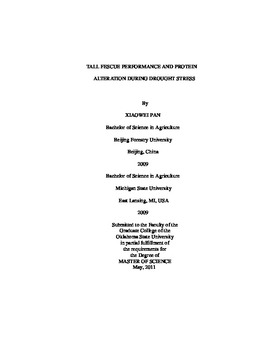| dc.contributor.advisor | Moss, Justin Quetone | |
| dc.contributor.author | Pan, Xiaowei | |
| dc.date.accessioned | 2014-04-15T22:32:26Z | |
| dc.date.available | 2014-04-15T22:32:26Z | |
| dc.date.issued | 2011-05-01 | |
| dc.identifier.uri | https://hdl.handle.net/11244/9590 | |
| dc.description.abstract | Cool-season turfgrasses are commonly under drought stress during the summer in the United States and often require supplemental irrigation to maintain acceptable turfgrass quality. A study was conducted at Oklahoma State University to evaluate the performance and protein alteration of tall fescue during drought stress. Three diverse cultivars of mature tall fescue (`Kentucky 31', `2nd Millennium' and `Rebel Exeda') were subjected to two treatments: well-water condition and drought. Volumetric soil water content (VSWC), leaf relative water content (RWC), turf quality (TQ) and electrolyte leakage (EL) were measured at 0, 7, and 11 d following treatments. In well-watered plants, root characteristics were measured at the end of the study period. Protein analysis was conducted to detect for changes of dehydrin protein expression.The VSWC was maintained at the same level for each treatment for all three cultivars throughout the study. There were no differences in RWC among the three cultivars under well-watered conditions throughout the study, but tall fescue RWC declined after initiation of the drought treatment. Under drought stress, TQ decreased for all three cultivars as drought stress increased but `Kentucky 31' had higher TQ compared to `2nd Millennium' and `Rebel Exeda' at 7d of drought treatment. After 11 of drought stress, there were no differences in TQ among the three cultivars and the average TQ rating was 2. The EL results suggested that the three cultivars had similar membrane stability under drought stress throughout the study period. Root length density, DRW, and RSA were highest in `2nd Millennium' in the 0-40 cm profile suggesting that `2nd Millennium' may have greater ability to avoid drought under field conditions. Drought stress induced expression of dehydrin proteins, but there were no differences in soluble proteins or dehydrin protein expression among the three cultivars. Although dehydrin polypeptides were observed in many studies and assumed to contribute to drought tolerance, the results of this study did not indicate a relationship between protein changes and drought tolerance in diverse tall fescue cultivars. | |
| dc.format | application/pdf | |
| dc.language | en_US | |
| dc.publisher | Oklahoma State University | |
| dc.rights | Copyright is held by the author who has granted the Oklahoma State University Library the non-exclusive right to share this material in its institutional repository. Contact Digital Library Services at lib-dls@okstate.edu or 405-744-9161 for the permission policy on the use, reproduction or distribution of this material. | |
| dc.title | Tall Fescue Performance and Protein Alteration During Drought Stress | |
| dc.type | text | |
| dc.contributor.committeeMember | Maness, Niels O. | |
| dc.contributor.committeeMember | Wu, Yanqi | |
| osu.filename | Pan_okstate_0664M_11345.pdf | |
| osu.college | Agricultural Sciences and Natural Resources | |
| osu.accesstype | Open Access | |
| dc.description.department | Horticulture and Landscape Architecture Department | |
| dc.type.genre | Thesis | |
